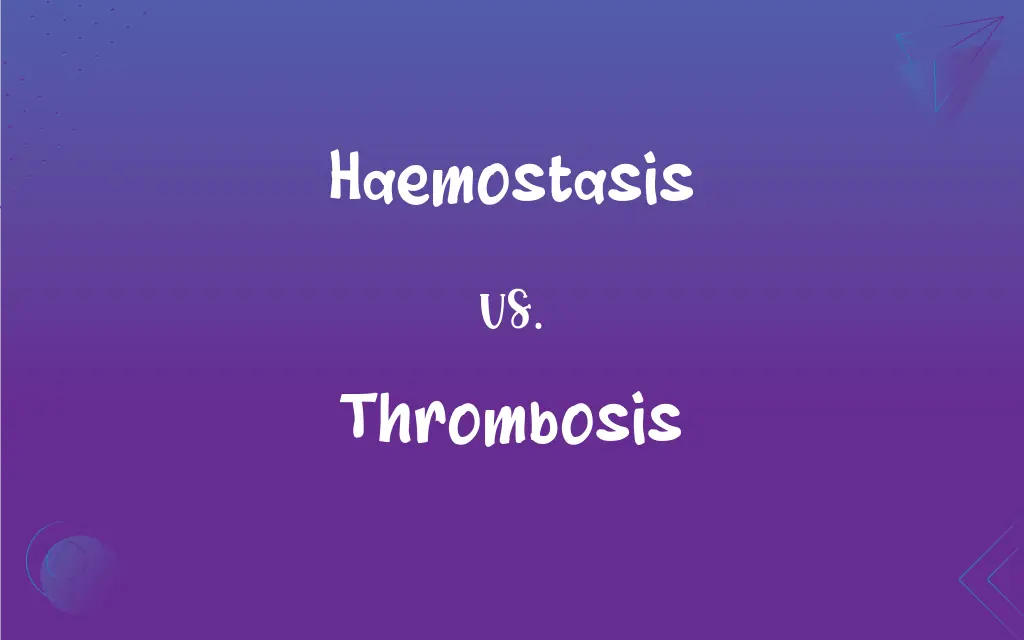Haemostasis vs. Thrombosis: What's the Difference?
Edited by Aimie Carlson || By Harlon Moss || Updated on October 28, 2023
Haemostasis is the process stopping bleeding, while thrombosis is the formation of unwanted blood clots.

Key Differences
Haemostasis is a natural mechanism that prevents and stops bleeding, ensuring blood remains within the circulatory system. Thrombosis, conversely, refers to the abnormal formation of blood clots within a vessel, which can obstruct blood flow.
Haemostasis serves a protective function, ensuring rapid sealing of injuries to the circulatory system. This process is vital for survival and is initiated when blood vessels are damaged. Thrombosis, on the other hand, can be detrimental, occurring even in undamaged vessels and potentially leading to conditions like strokes or heart attacks.
Both haemostasis and thrombosis involve blood components like platelets and clotting proteins. Haemostasis is tightly regulated, encompassing processes such as vasoconstriction, platelet plug formation, and coagulation. Thrombosis, however, results from imbalances in these systems, often due to factors like vessel wall damage, abnormal blood flow, or altered blood composition.
While haemostasis is essential for survival, its dysregulation can contribute to thrombosis. Abnormal haemostasis can cause excessive bleeding or clotting. Thrombosis can lead to severe medical conditions, depending on the clot's location; for instance, in arteries supplying the brain or heart, thrombosis can cause strokes or heart attacks, respectively.
Medical interventions often aim to support haemostasis in situations like surgeries or trauma to prevent excessive bleeding. Conversely, with thrombosis, the goal is typically to dissolve or prevent the formation of clots, often employing anticoagulants or thrombolytic agents.
ADVERTISEMENT
Comparison Chart
Purpose
Prevents and stops bleeding
Abnormal clot formation inside a blood vessel
Occurs In
Damaged blood vessels
Can occur in undamaged vessels
Consequence
Essential for survival
Can lead to life-threatening conditions
Mechanisms Involved
Vasoconstriction, platelet plug formation, coagulation
Often due to imbalances in haemostatic systems
Clinical Interventions
Support in trauma or surgery to prevent bleeding
Use of anticoagulants or thrombolytics to prevent/dissolve clots
ADVERTISEMENT
Haemostasis and Thrombosis Definitions
Haemostasis
The body's mechanism to stop bleeding.
Haemostasis quickly occurred after the minor cut.
Thrombosis
The formation of blood clots inside vessels.
Deep vein thrombosis can lead to serious complications.
Haemostasis
A protective response preventing blood loss.
Surgical procedures rely on effective haemostasis.
Thrombosis
Can occur in veins or arteries and can be life-threatening.
The doctor advised him about the dangers of pulmonary thrombosis.
Haemostasis
Regulation of blood flow and clotting after vessel injury.
Without proper haemostasis, even minor injuries could be fatal.
Thrombosis
Resulting from imbalances in the haemostatic system.
Certain medications increase the risk of thrombosis.
Haemostasis
The process encompassing vasoconstriction, platelet action, and coagulation.
Defects in haemostasis can lead to excessive bleeding or clotting.
Thrombosis
An abnormal clotting event potentially obstructing blood flow.
Thrombosis in coronary arteries can cause heart attacks.
Haemostasis
A balanced system preventing hemorrhage and thrombosis.
Studying haemostasis helps understand various bleeding disorders.
Thrombosis
A pathological process leading to unwanted clot formation.
The patient was diagnosed with cerebral thrombosis.
Haemostasis
(British spelling) hemostasis
Thrombosis
The formation, presence, or development of a thrombus.
FAQs
What are common causes of thrombosis?
Thrombosis can be caused by vessel wall damage, abnormal blood flow, or altered blood composition.
What triggers haemostasis in the body?
Haemostasis is triggered by vascular injury or damage to prevent bleeding.
What complications can arise from untreated thrombosis?
Untreated thrombosis can lead to conditions like pulmonary embolism, heart attacks, or strokes.
How does the body ensure haemostasis?
The body uses mechanisms like vasoconstriction, platelet plug formation, and coagulation for haemostasis.
Are haemostasis and thrombosis interconnected?
Yes, while haemostasis prevents bleeding, its dysregulation can contribute to thrombosis.
Is haemostasis a rapid process?
Yes, haemostasis is typically a rapid process to minimize blood loss.
How is haemostasis beneficial during surgeries?
Haemostasis ensures minimal blood loss and aids in wound healing during surgeries.
Are there types of thrombosis?
Yes, thrombosis types include venous (like DVT) and arterial (like coronary thrombosis).
Can drugs affect haemostasis?
Yes, certain drugs can enhance or inhibit haemostasis, affecting bleeding or clotting.
What factors predispose an individual to thrombosis?
Genetics, immobility, surgeries, and certain medications are factors predisposing to thrombosis.
Are there tests to evaluate haemostasis?
Yes, tests like clotting time, platelet count, and coagulation factor assays evaluate haemostasis.
Can lifestyle influence thrombosis risk?
Yes, sedentary lifestyle, smoking, and obesity can increase thrombosis risk.
What happens if haemostasis is not effectively achieved?
Ineffective haemostasis can result in excessive bleeding or clotting disorders.
How is thrombosis treated?
Thrombosis is often treated with anticoagulants or thrombolytic agents.
Is the role of platelets essential in haemostasis?
Yes, platelets play a crucial role in forming a plug at the injury site during haemostasis.
Is thrombosis always harmful?
Thrombosis can be life-threatening, especially when clots obstruct vital blood vessels.
Does haemostasis involve only clotting mechanisms?
No, haemostasis involves vasoconstriction, platelet action, and clotting mechanisms.
Which conditions increase the risk of thrombosis?
Conditions like deep vein thrombosis, atrial fibrillation, and certain genetic mutations increase thrombosis risk.
Can thrombosis occur without evident causes?
Yes, thrombosis can sometimes occur without clear causes or evident vessel damage.
Can thrombosis lead to strokes?
Yes, thrombosis in brain arteries can cause strokes.
About Author
Written by
Harlon MossHarlon is a seasoned quality moderator and accomplished content writer for Difference Wiki. An alumnus of the prestigious University of California, he earned his degree in Computer Science. Leveraging his academic background, Harlon brings a meticulous and informed perspective to his work, ensuring content accuracy and excellence.
Edited by
Aimie CarlsonAimie Carlson, holding a master's degree in English literature, is a fervent English language enthusiast. She lends her writing talents to Difference Wiki, a prominent website that specializes in comparisons, offering readers insightful analyses that both captivate and inform.































































